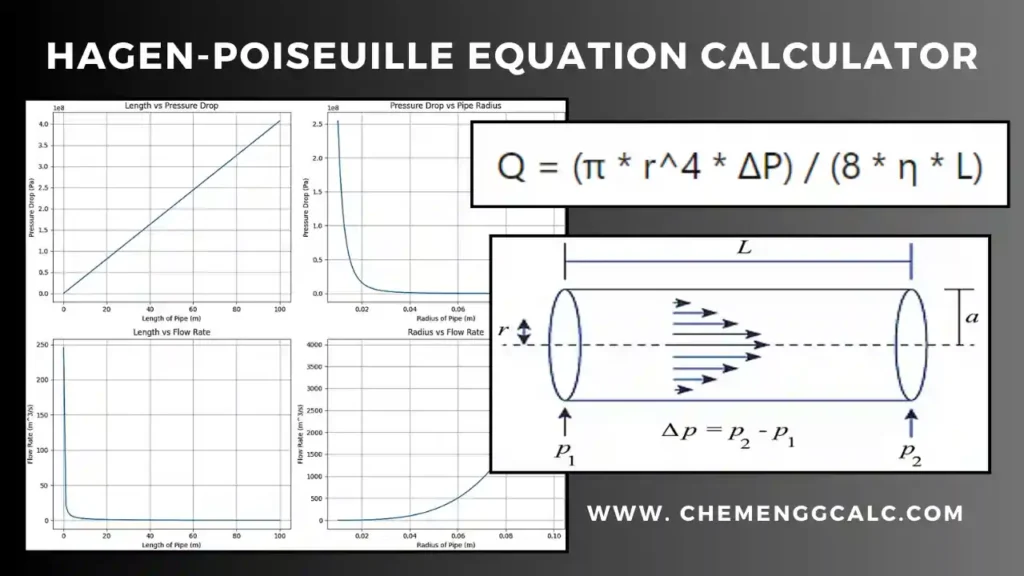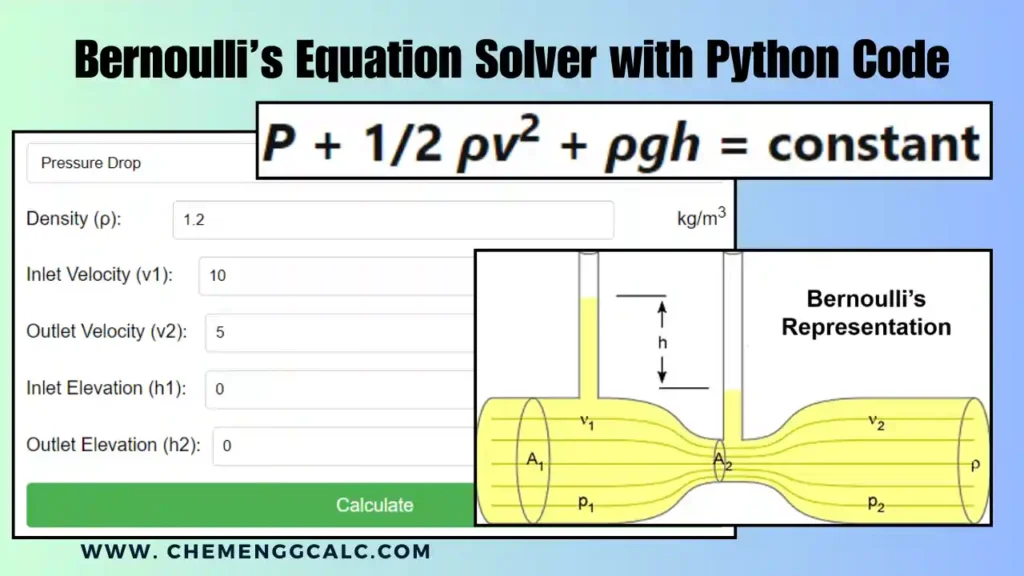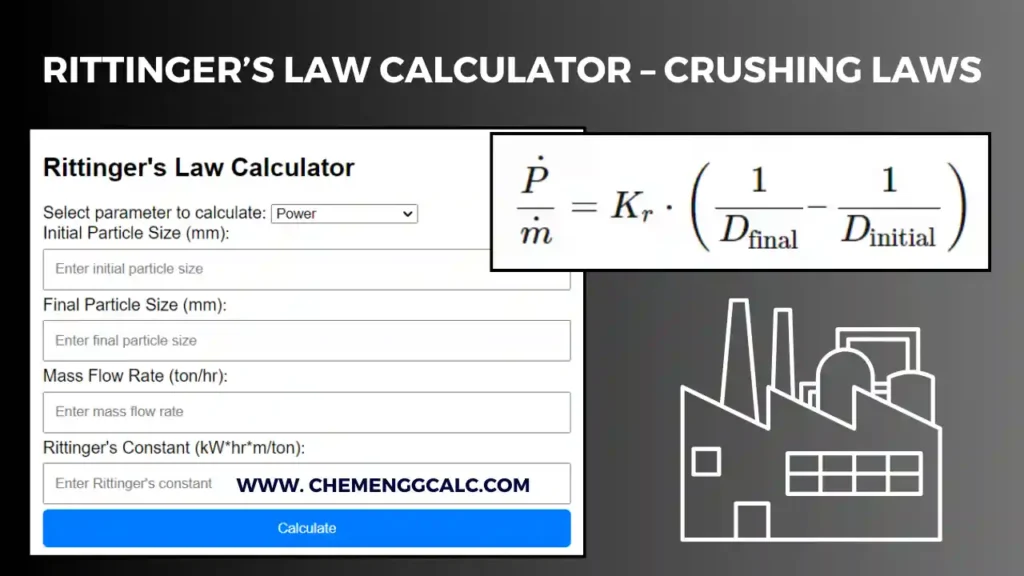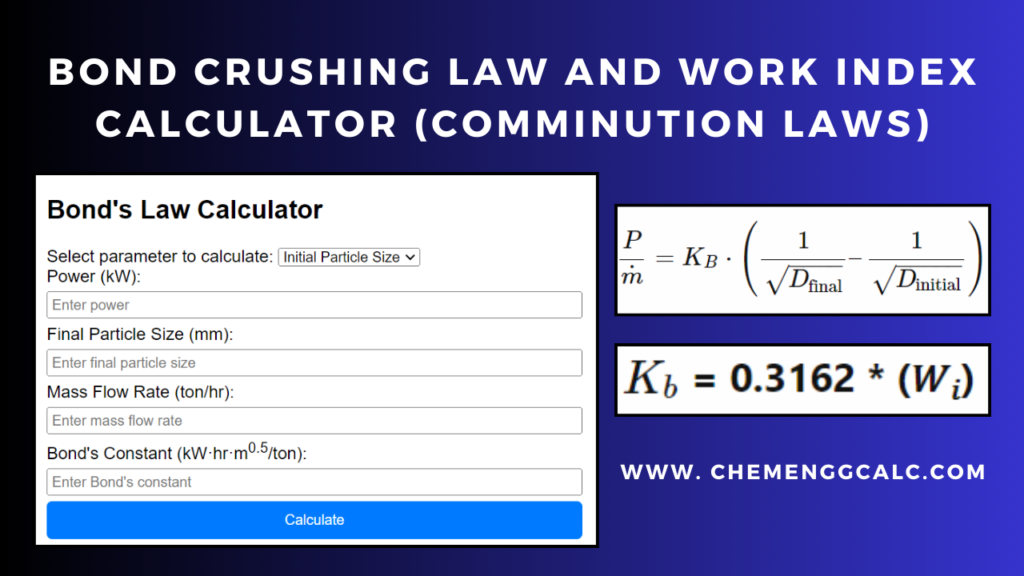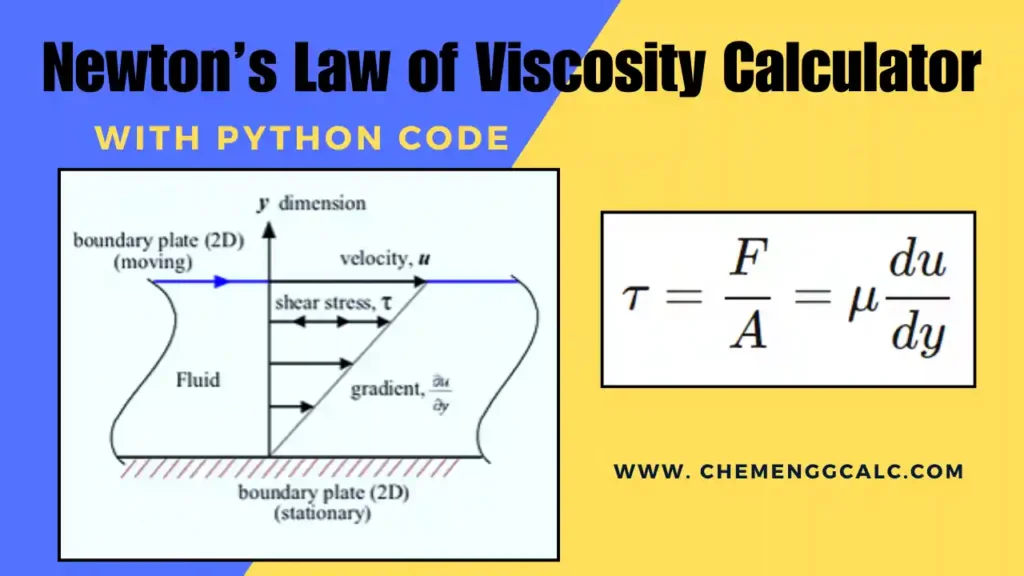Table of Contents
In Mechanical Operations, Cake filtration is a commonly used method where solid particles in a suspension are separated by passing the mixture through a porous medium. As the slurry passes through a filter medium, solid particles gets collected, forming a cake that helps collect more solid particles.
The efficiency of filtraton process depends on the resistance of the filter material and the resistance of the cake itself. These factors are useful in optimizing filtration systems for better performance and cost-effectiveness.
Related: Darcy’s Law Calculation for flow through porous media – Assumption & Applications
Cake Filtration Equation
Cake Filtration equaiton is the mathematical representation of filtration process. It models formation and growth of filter cake on a filter medium (usually filter cloth or membrane) during filtration.
The general form of the cake filtration equation is:
\[\frac{dV}{dt} = \frac{A \cdot \Delta P}{\mu \cdot (R_m + R_c)}\]
\[\frac{dV}{dt} = \frac{A \cdot \Delta P}{\mu \cdot (R_m + \alpha \cdot w)}\]
where in S.I units:
- dV/dt is the filtration rate (volume of filtrate per unit time, m3/s)
- A is the filtration area, m2
ΔP is the pressure drop across the filter cake and medium, Pa or kPa
- μ is the viscosity of the filtrate, Pa. s
- Rm is the resistance of the filter medium, m-1
- Rc = α.w is the resistance of the filter cake, m-1
- α is specific cake resistance, m/kg
- w is the mass of dry cake per unit area, kg/m2
Note: The cake filtration equation is derived from Darcy’s law, which describes the flow of fluids through porous media. The total resistance to flow is the sum of the resistance of the filter medium (Rm) and the resistance of the cake (Rc).
Note: During filtration process, either the pressure drop increases or the flow rate decreases. In constant pressure filtration, the pressure drop remains same while the flow rate decreases over time. In constant rate filtration, the pressure drop is gradually increased to maintain a consistent flow rate.
Related: Ergun Equation Calculator for Pressure Drop in Packed Bed Column
Related: Head Loss or Pressure Loss Calculator using Darcy-Weisbach Equation
Constant Pressure Filtration
In constant pressure filtration the mixture is passed through a filter medium under a constant pressure difference and the rate of filtration gradually decrease over time due to continuous buildup of the filter cake providing more resistance to the flow.
The cake filtration equaiton for constant pressure filtration is written as:
\[\frac{t}{V} = \frac{\mu \alpha c}{2A^2 \Delta P} V + \frac{\mu R_m}{A \Delta P}\]
Note: This equation is applicable for incompressible filter cake (i.e., the specific cake resistance α is constant) and the flow is laminar.
The above equation is written in the form of linear equation Y = MX + C
Filter Medium and Specific Cake Resistance Calculator
This filtration resistance calculator helps user to determine the specific cake resistance (α) and filter medium resistance (Rm) for a constant pressure filtration process.
How to use calculator: User can input the data for volume of filtrate and filtration time along with filtration parameters (viscosity, concentration, filtration area, and pressure drop). It then plot the t/V vs V plot and performs linear regression.
Based on the caluclated values of slope and intercept it computes the α and Rm using the filtration equation.
Related: Power Consumption Calculator for an Agitated Vessel – Step by Step Guide
Related: Bernoulli’s Equation Calculator / Solver – Interactive Python Code
Constant Pressure Filtation Equation Derivation
Constant Pressure Filtration Equation gives the relationship between the filtration time (t) and the volume of filtrate (V) collected during filtration process for given pressure difference.

For the derivation, we will start with the concept of fluid flow passed through the porous medium (filter cake and filter medium), applying darcy’s law of permeability, we get:
\[\frac{dV}{dt} = \frac{A \Delta P}{\mu (R_m + R_c)}\]
Here, Rm is the resistance due to filter medium and Rc is the resistance due to filter cake.
For the resistance of the filter cake, it is proportional to the mass of solids deposited per unit area. If c is the concentration of solids in the slurry (mass of solids per unit volume of filtrate), then the mass of solids deposited per unit area is \( \frac{cV}{A} \). Therefore:
\[R_c = \alpha \left( \frac{cV}{A} \right)\]
where, α is the specific cake resistance (a property of the filter cake)
Now substituting the Rc into darcy’s law, we get:
\[\frac{dV}{dt} = \frac{A \Delta P}{\mu \left( R_m + \alpha \frac{cV}{A} \right)}\]
Rearranging above equation to separate variables V and t:
\[\left( R_m + \alpha \frac{cV}{A} \right) dV = \frac{A \Delta P}{\mu} dt\]
Integrating both side with limits from ( V = 0 ) to ( V = V ) and ( t = 0 ) to ( t = t ), we get:
\[\int_0^V \left( R_m + \alpha \frac{cV}{A} \right) dV = \int_0^t \frac{A \Delta P}{\mu} dt\]
On integration and rerrange to the filtration equation
\[\frac{R_m V}{A \Delta P} + \frac{\alpha c V^2}{2A^2 \Delta P} = \frac{t}{\mu}\]
Rearrange it to get the final constant pressure filtration equation is:
\[\frac{t}{V} = \frac{\mu \alpha c}{2A^2 \Delta P} V + \frac{\mu R_m}{A \Delta P}\]
This equation is in the linearized form, where m is the slope and b is the intercept, therefore:
\[\text{slope} = \frac{\mu \alpha c}{2A^2 \Delta P}\]
This terms represents the resistance due to the filter cake and units are given as s/m6
\[\text{intercept} = \frac{\mu R_m}{A \Delta P}\]
This terms represents the resistance due to the filter medium and units are given as s/m3
Now, by plotting the experimental data for t/V vs V, we can determine the slope and intercept and then calculating the filter medium resistance (Rm) and the specific cake resistance (α).
Related: Newton’s Law of Viscosity Calculator – Dynamic Viscosity
Related: Sphericity Calculator for different shapes
Example Problem on Cake Filtration
Calculate the filtration constants for the constant-pressure filtration at a pressure of 194.4 kN/m². The volume of filtrate (V) and the corresponding filtration time (t) data is given below:
| V×103 (m³) | 0.50 | 1.00 | 1.50 | 2.00 | 2.50 | 3.00 | 3.50 | 4.00 | 4.50 | 5.00 |
| t (s) | 6.30 | 14.00 | 24.20 | 37.00 | 51.70 | 69.00 | 88.80 | 110.00 | 134.00 | 160.00 |
Solution:
Data Given:
- Pressure Difference (ΔP) = 194.4 kN/m² = 194400 Pa
- Area of Filtration, (A) = 1 m2
- Viscosity of Filtrate (μ) = 0.001 Pa.sec
- Concentration of Solids (c)= 10 kg/m³
From the given data, we will first plot calculate the t/V data and then plotting it against V to get the desired form of cake filtration equation.
| V×103 (m³) | t (s) | V (m³) | t/V (s/m³) |
|---|---|---|---|
| 0.50 | 6.30 | 0.00050 | 12600.00 |
| 1.00 | 14.00 | 0.00100 | 14000.00 |
| 1.50 | 24.20 | 0.00150 | 16133.33 |
| 2.00 | 37.00 | 0.00200 | 18500.00 |
| 2.50 | 51.70 | 0.00250 | 20680.00 |
| 3.00 | 69.00 | 0.00300 | 23000.00 |
| 3.50 | 88.80 | 0.00350 | 25371.43 |
| 4.00 | 110.00 | 0.00400 | 27500.00 |
| 4.50 | 134.00 | 0.00450 | 29777.78 |
| 5.00 | 160.00 | 0.00500 | 32000.00 |
From the data calculation we will plot the t/V vs V data and measure the slope and intercept for this plot:
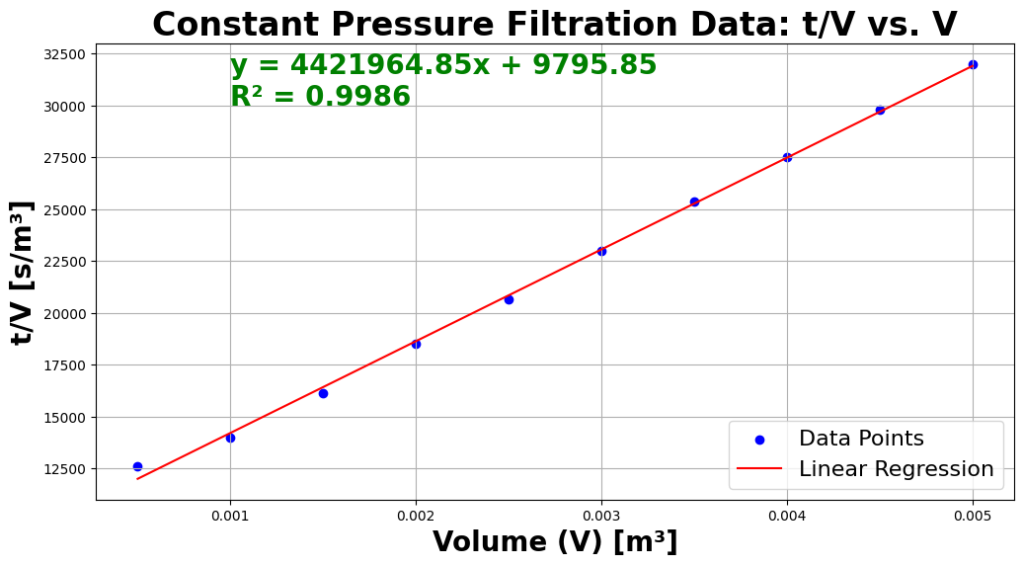
From above plot, we get the values of slope = 4.42 x 106 and intercept = 9.795 x 103
we will be putting these values in the equation \(\text{slope} = \frac{\mu \alpha c}{2A^2 \Delta P}\) for the calculation of specific cake resistance and \(\text{intercept} = \frac{\mu R_m}{A \Delta P}\) for the calculation of filter medium resistance.
we will use python for ease of calculation, here is the python code given
# Given values
slope = 4421964.85 # Slope from linear regression (s/m^6)
intercept = 9795.85 # Intercept from linear regression (s/m^3)
delta_P = 194400 # Pressure difference (Pa)
A = 1 # Filtration area (m^2)
mu = 0.001 # Viscosity of filtrate (Pa·s)
c = 10 # Concentration of solids (kg/m^3)
# Calculate specific cake resistance (alpha)
alpha = (2 * A**2 * delta_P * slope) / (mu * c)
print(f"Specific Cake Resistance (α): {alpha:.2e} m/kg")
# Calculate filter medium resistance (R_m)
R_m = (intercept * A * delta_P) / mu
print(f"Filter Medium Resistance (R_m): {R_m:.2e} m⁻¹")Output:
Specific Cake Resistance (α): 1.72e+14 m/kg
Filter Medium Resistance (R_m): 1.90e+12 m⁻¹
Therefore, the filtration constants values are Specific Cake Resistance (α) = 1.72e+14 m/kg and Filter Medium Resistance (Rm)= 1.90e+12 m⁻¹
Related: Hagen-Poiseuille Equation Calculator / Poiseuille’s Law Solver
Related: Screen Analysis – Differential and Cumulative Distribution
Resources:
- “Unit Operations in Chemical Engineering” (McCabe et al.)
- “Particle Technology and Separation Processes” (Richardson et al.)
- “Chemical Engineering Design: Principles, Practice and Economics of Plant and Process Design” (Towler and Sinnott)
- Handbook of Chemical Engineering calculations, Chopey et al, McGraw Hill, 2004
Disclaimer: The Solver provided here is for educational purposes. While efforts ensure accuracy, results may not always reflect real-world scenarios. Verify results with other sources and consult professionals for critical applications. Contact us for any suggestions or corrections.

